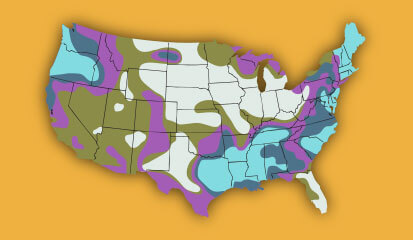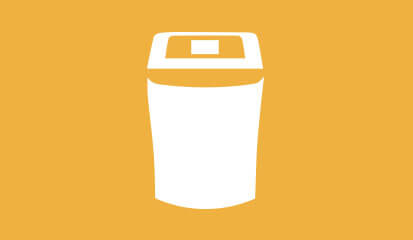Hard Water & Water Softening Systems FAQ
How is the “hardness” of water measured?
How do I find out my water hardness?
Why does soft water make my skin feel different?
Is it the salt in my water that’s making my skin feel oily?
Does the salt soften my water?
What does the grain capacity of a water softener mean?
What type of salt should I use?
What if I’m on a sodium-restricted diet?
Water softeners using sodium chloride (salt) for regeneration add a minor amount of sodium to the water. Persons on sodium-restricted diets should consider the added sodium as part of their overall intake. If sodium intake is a concern, consider using Potassium Chloride (KCl) salt for regeneration or investing in in a reverse osmosis drinking water system.
| Initial Water Hardness | Sodium Added by Cation Exchange Softening of Water* | Potassium Added by Cation Exchange Softening of Water** |
| 1 grains per gallon | 7.5 milligrams of sodium/quart | 12.75 milligrams of potassium/quart |
| 5 | 37 | 62.9 |
| 6 | 44 | 74.8 |
| 7 | 52 | 88.4 |
| 8 | 60 | 102.0 |
| 9 | 68 | 115.6 |
| 10 | 75 | 127.5 |
| 15 | 112 | 190.4 |
| 20 | 150 | 255.0 |
| 30 | 225 | 382.5 |
| 40 | 300 | 510 |
**One large banana, about 9 inches in length, has approximately 600 milligrams of potassium.
What is the difference between an ‘old’ and ‘new’ water softener?
The age, design, salt efficiency, and warranty are often different between ‘old’ and ‘new’ water softeners.
Age: Like any other appliance, a water softener’s efficacy starts to decline after years of constant use. A softener’s average lifespan is about 10-15 years. If your water is abnormally hard or full of other impurities, it takes a greater toll on the appliance much more quickly. If your water is low to moderately hard, it won’t have to be regenerated as often, extending the life of the appliance a few more years beyond the average lifespan.
Design: A ‘two tank’ structure is common for products utilizing older softener technology. Typically two tank units are built by separate companies at separate facilities and the components are not designed and integrated to work together efficiently. These two tank models also consume more floor space than single tank cabinet unit. Whirlpool® water softeners are all single tank softeners and are designed, engineered and assembled at the same plant in the United States, ensuring the highest levels of quality.
Salt Efficiency: A softener uses salt to regenerate, or ‘clean’ itself of the hardness particles it collects during regular operation. Older softener technology utilizes a timer and regenerates at regular intervals regardless of water consumption. These models aren’t ideal if your water usage varies. If you underestimate your water usage (i.e., extra loads of laundry, extra guests), and your water softener regenerates too infrequently, you will allow hard water to flow throughout your home. On the flip side, overestimating your water use will result in unnecessary regeneration, wasting water, salt and energy. However, Whirlpool® Water Softeners regenerate only when needed based on your family’s water use, a process called Demand Initiated Regeneration. The use of this technology greatly reduces the amount of water and salt Whirlpool® units will consume.
Warranty: Many older softeners will come with warranties that can sound appealing. However, these warranties are usually for the parts and material only and frequently require a trip charge or other hidden costs. Whirlpool® units come with a minimum 1-year in home parts and labor warranty (warranty varies by model).
How do I extend my full-coverage warranty with Whirlpool® Water Softener Cleanser?
Purchasing 3 bottles of Whirlpool Water Softener Cleanser (model WHE-WSC) every year will extend your full parts and labor warranty for an additional year. Water Softener extended warranties cap out at 5 years or 10 years depending on model. For warranty details, click here. To validate and extend your Whirlpool Water Softener warranty, register your product online and upload your purchase receipts.
Recommended usage: pour a full bottle of the Softener Cleanser into the brine well every four months. After pouring the Softener Cleanser into the brine well, press and hold the Recharge button until a recharge commences. The Softener Cleanser will keep your softener free of contaminants, iron, and hard water build-up that can affect the system and reduce efficiency.
What makes Whirlpool® Water Softeners more salt efficient than other models?
Water softeners require salt to regenerate, or ‘clean’ itself of the hardness particles it collects during regular operation. The amount of salt used in this process is called a ‘salt dose’. Most other softeners have a defined salt dose, meaning they have to be set either on ‘high capacity’ or ‘high efficiency’. When it is set to ‘high capacity’ the unit will regenerate less frequently but use a significant amount of salt to regenerate. When it is set on high efficiency, it will use less salt per cleaning cycle, but must regenerate more frequently. Either way, the unit will consume a significant amount of salt and water. Whirlpool® units employ a ‘variable salt dose’, meaning the amount of salt used to clean the system will vary depending on the amount of hardness the system has collected. Similar to the benefits of Demand Initiated Regeneration, this variable salt dose process results in a significant reduction in the amount of salt and water the system will use.
Whirlpool® units also include an exclusive feature that ‘learns’ the consumer’s water usage patterns and employ a predictive algorithm to anticipate the amount of water and hardness particles that will run through it. This feature allows the system to regenerate when it is most efficient and also prevents the consumer from running out of soft water.
Finally, Whirlpool® units are certified by NSF, an independent third party, for structural integrity, grain capacity and efficiency. Other units may carry the NSF certification, but they are commonly certified for structural integrity only, not efficiency or capacity.

